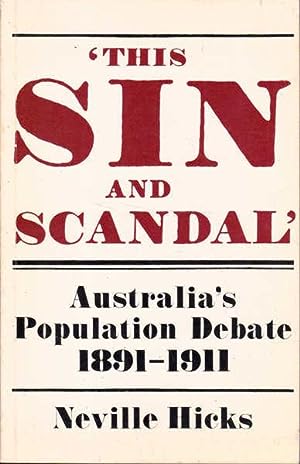
- Free Article: No
- Contents Category: Australian History
- Review Article: Yes
- Article Title: False and Pernicious Doctrine
- Online Only: No
- Custom Highlight Text:
Perhaps no other social attitude has changed so markedly in this century as the prevailing public reaction towards the question of the limitation of population growth and the use of birth control devices.
- Book 1 Title: This Sin and Scandal
- Book 1 Subtitle: Australia’s population debate 1891–1911
- Book 1 Biblio: ANU Press, $12.15, 208 pb
- Book 1 Cover Small (400 x 600):

- Book 1 Cover (800 x 1200):

Neville Hicks’ book, This Sin and Scandal, sets out to examine the extensive public debate about the population question which occurred in the Australian colonies in the decades around the turn of the century.
From 1890 onwards, the birth-rate of each state showed the sharp decline characteristic of many Western nations at that time. For the new colonies, fearing that their hold on the Australian continent was a precarious one, experiencing depression and diminishing immigration, the decline in natural increase seemed alarming. In New South Wales, the colony where the decline was most pronounced, the crude birth-rate fell from 34.5 live births per 1,000 of the population in 1891 to 25.3 in 1903. Average family size decreased from seven for a woman completing her childbearing in 1891, to four or fewer children within a generation.
Such was the public concern that in 1903 the New South Wales government established a Royal Commission which heard evidence for six months, and published a notable report in the following year, establishing that the principal cause of the fall in the birth-rate was the general use by married couples of contraception. The underlying motivation was one of purely personal selfishness – ‘We have been reluctantly, but inevitably, driven to the conclusion,’ the Commissioners wrote, ‘that the people, led astray by false and pernicious doctrine...are neglecting their true duty to themselves, to their fellow countrymen, and to posterity’, and further that the waning birth-rate was seen ‘as a grave disorder sapping the vitals of a new people, dispelling its hopes, blighting its prospects, and threatening its continuance’. They castigated their fellow citizens for loving luxuries and social pleasures, and avoiding the strain and discomfort involved in bearing and rearing children.
Hicks structures his investigation of the population debate around the Commission, starting with its composition, deliberations and findings, and proceeding to analyse the ideological origins of the various strands of opinion represented in the Report. He carefully describes the perspectives represented by the doctors, the clergy, by economists, newspaper editors and the general public in turn, teasing out from a mass of detailed evidence the subtly varying world views held by each. The book ends with a survey of the work of Australia’s first government statisticians.
It is undoubtedly a fine piece of historical reconstruction, painstakingly researched, precise, thick-textured. The subject matter is, of course, fascinating in itself, and he adopts a pleasing style which, while never trivialising or distorting his material, avoids also a too stolid or pedantic approach. We are offered an intensely interesting and illuminating insight into one important area of late Victorian and Edwardian thinking.
Some readers will not be entirely satisfied. More context and explanation would have been of use: Malthusianism and neoMalthusianism, for example, are terms used with no introduction. The work obviously invites comparison with the British study by J.A. Banks, Prosperity and Parenthood, but it is narrower in focus, less broadly conceived. It is a pity that other related studies by the author, available only in article form, had not been integrated into the book, particularly his examination of differentials in fertility patterns between classes, geographical areas and religious groups (Historical Studies, vol. 16, No. 65). The lack of context obscures the fact which is mentioned only in passing, that the fall in the birth-rate was a phenomenon which continued, with fluctuations, to the present day, and was not attached temporarily to the colonial depression.
It is indicative of the apposite nature of Hicks’ work that he touches on issues of such current importance that one wishes he might have had time to pursue them further. In the area of women’s history, the adoption of birth-control is of vital concern. What were the implications of contraception use for concepts of women’s place in society? How did notions of population control relate to ideologies stressing companionate marriage and child-centred family life? What was the relationship of the use of contraception to another current social reform movement, feminism? This Sin and Scandal whets the appetite for further scholarly inquiry of these and related issues.
Social history has for too long been the poor relation of Australian historiography. Recent years have witnessed the publication of a number of studies in this field. Hicks has made another highly valuable contribution.


Comments powered by CComment